Nutritious Backpacking Meal Recipes
These tasty and nutritious backpacking meal recipes are healthier, have more calories and cost less than commercial, freeze dried backpacking meals. Keep it simple — there are enough nutritious backpacking meal recipes here to provide sufficient daily variety to keep meals fun and interesting. But there aren’t so many recipes that I spend too much time buying ingredients and assembling a large inventory of gourmet meals. I’d rather spend my time hiking than fussing with food.
Note: This is a companion piece to my top rated post, Best Backpacking Food – simple and nutritious – veggie and omnivore friendly which has more detailed info on nutrition and backpacking food choices.
Photo: Author eating dinner in the Alaska Range – credit: Andrew Skurka
You make Adventure Alan & Co possible. When purchasing through links on our site, we may earn an affiliate commission at no additional cost to you. Here’s why you can trust us.
| Quick Links to Recipes | ||
|---|---|---|
| Link to Breakfast Recipes | Link to Dinner Recipes | Link to Desserts/Hot Drinks |
Meal Rotation Planner — Nutritious Backpacking Meal Recipes
Keep it simple — I rotate 2 to 3 meal options for each trip. This provides enough food variety on the trail. By limiting meals to 2 to 3 nutritious backpacking meal recipes, I simplify food purchasing and meal prep.
| Backpacking Meal Planner – example of a 3-day rotation | |||
|---|---|---|---|
| Day | Breakfast | Lunch | Dinner |
| 1 | None: eat large one off-trail | #1 Wrap+cheese & mustard (fruit #1) | #1 Rice+beans w chips+cheese |
| 2 | #1 Muesli | #2 Bison+sesame stix (dried fruit #2) | #2 Couscous curry |
| 3 | #2 Hot oatmeal/cream-o-wheat | #3 Crackers+almond butter (fruit #3) | #3 Chili mac |
| 4 | #3 Grape-Nuts + strawberries | #1 Wrap+cheese & mustard (fruit #1) | #1 Rice+beans w chips+cheese |
| 5 | #1 Muesli | #2 Bison+sesame stix (dried fruit #2) | #2 Couscous curry |
| 6 | #4 Quick breakfast meal bar | #3 Crackers+almond butter (fruit #3) | None: eat large one off-trail |
If you don’t already have one get an inexpensive kitchen scale that weighs up to 11 pounds (5 Kg). Almost all the ingredients are measured by weight for these recipes.
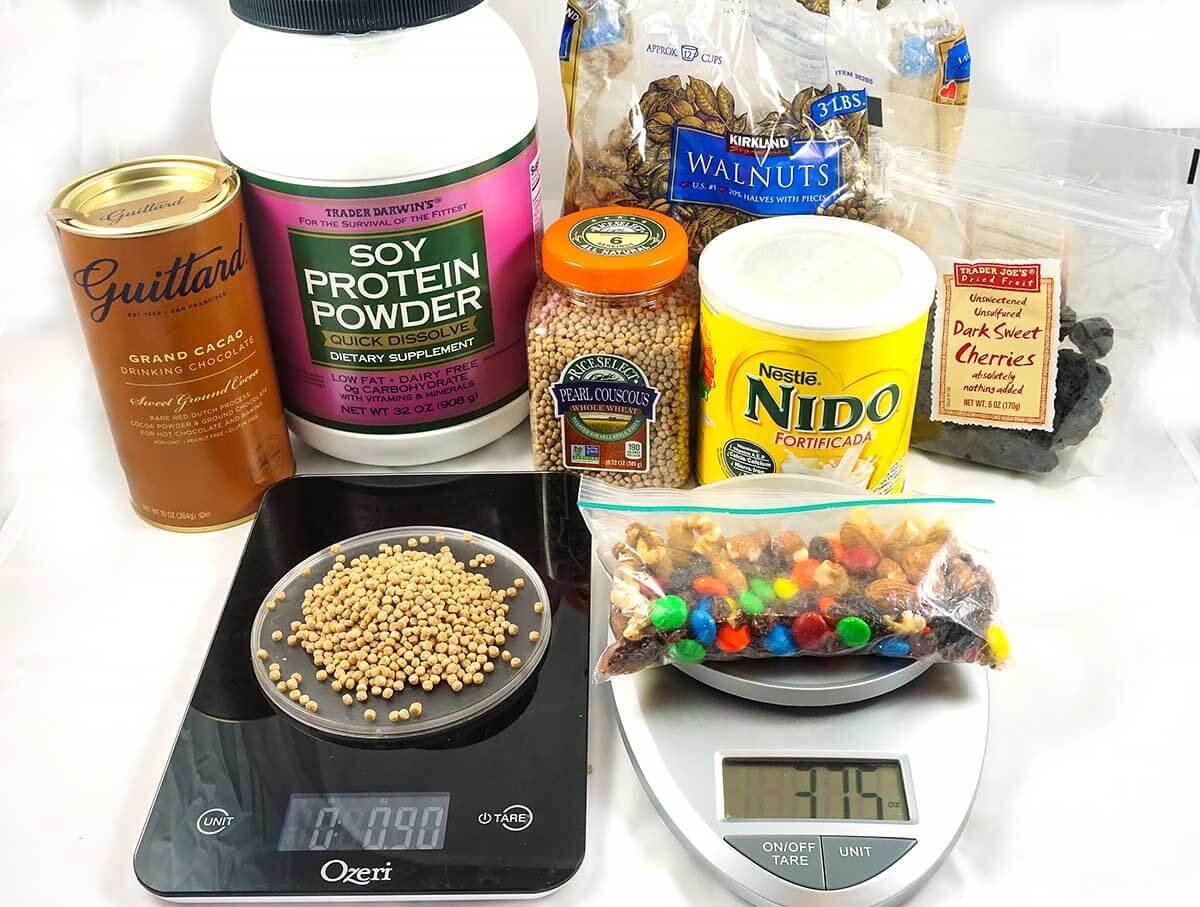
If you don’t already have one get an inexpensive kitchen scale that weighs up to 11 pounds (5 Kg). Almost all the ingredients are measured by weight for these recipes.
Breakfast Recipes
The following are nutritious and filling breakfasts that should keep a spring in your step until lunch! They have healthy fats and a good amount of protein. Note that the table below is in scrollable window. Please scroll down to see all the recipes Or you can see ALL THE RECIPES full page here, as a Google Sheet
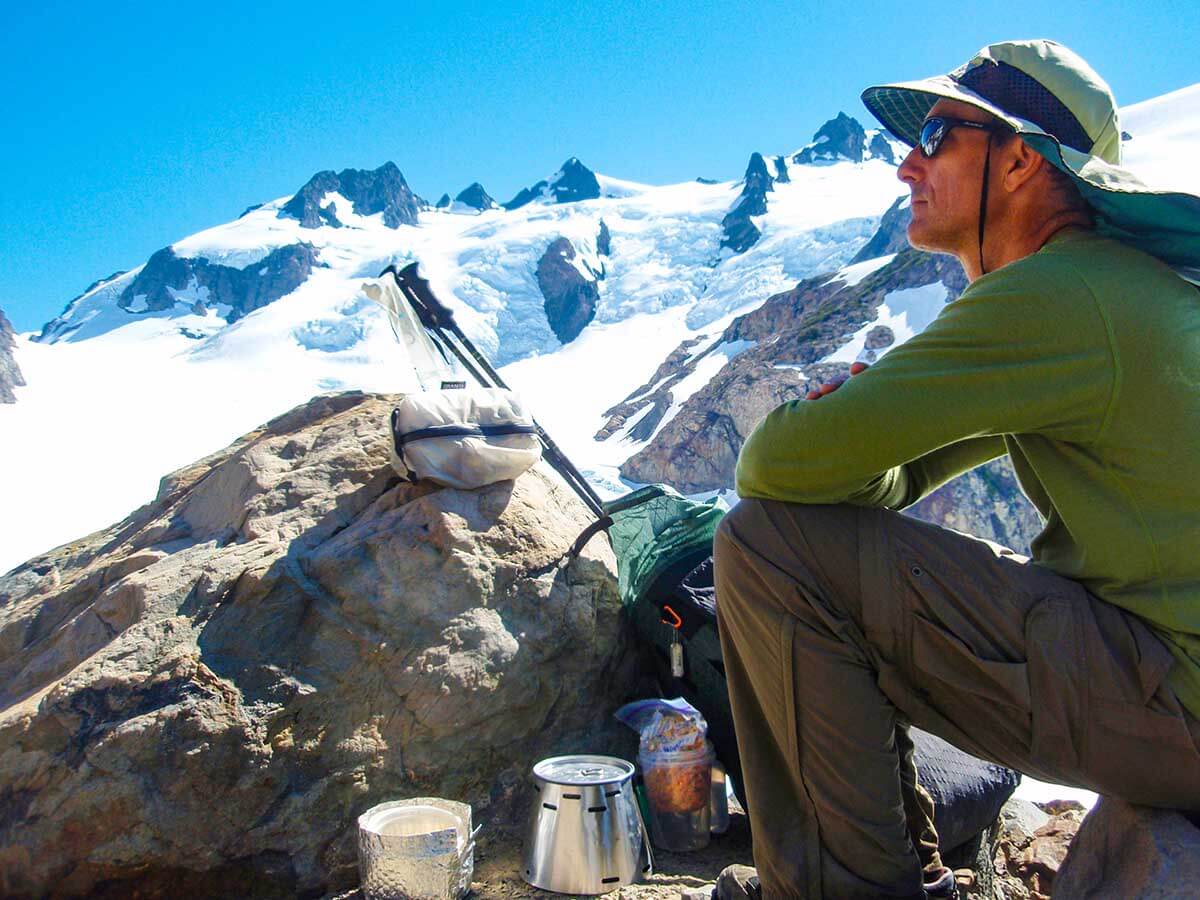
Dinner mid-way up Mt. Olympus, Olympic Peninsula, Washington State.
Dinner Recipes
The following are nutritious backpacking dinner recipes. These are filling meals at around 700-800 calories per serving! They have healthy fats and a good amount of protein. Note that the table below is in scrollable window. Please scroll down to see all the recipes Or you can see ALL THE DINNER RECIPES on a full page here, as a Google Sheet
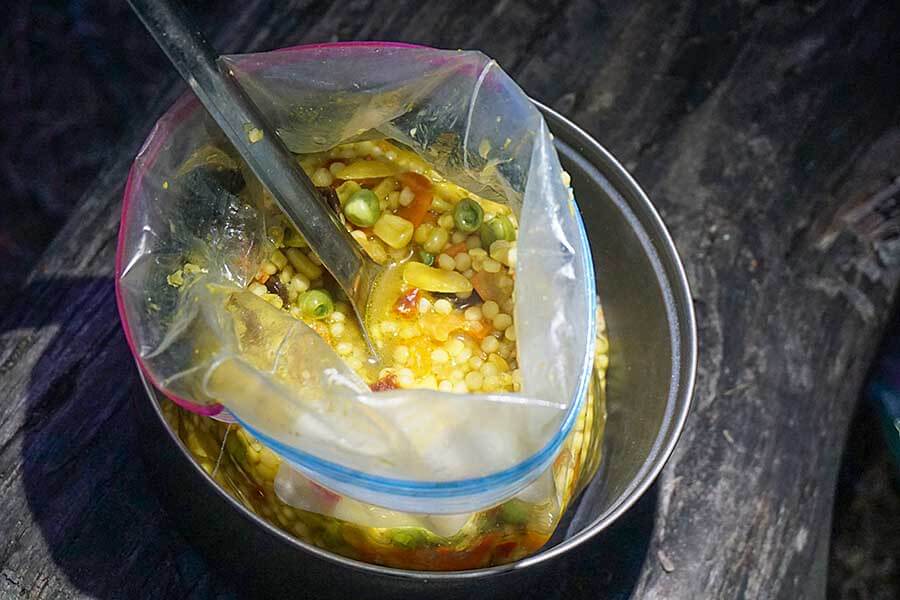
Rehydrating in a Ziplock bag makes cleanup much easier. Especially nice in “dry” camps. You usually use less fuel as you kill your stove as soon as the water boils. Downside is that the meal does not rehydrate as well as when it’s cooked in the pot, and rehydration can take longer. A long handled spoon pictured here helps reach into deep baggies without getting your fingers covered in food.
Dessert and Hot Drink Recipes
The following are just few ideas for desserts and after dinner drinks. Note that the table below is in scrollable window. Please scroll down to see all the recipes Or you can see ALL THE DINNER RECIPES full page here, as a Google Sheet
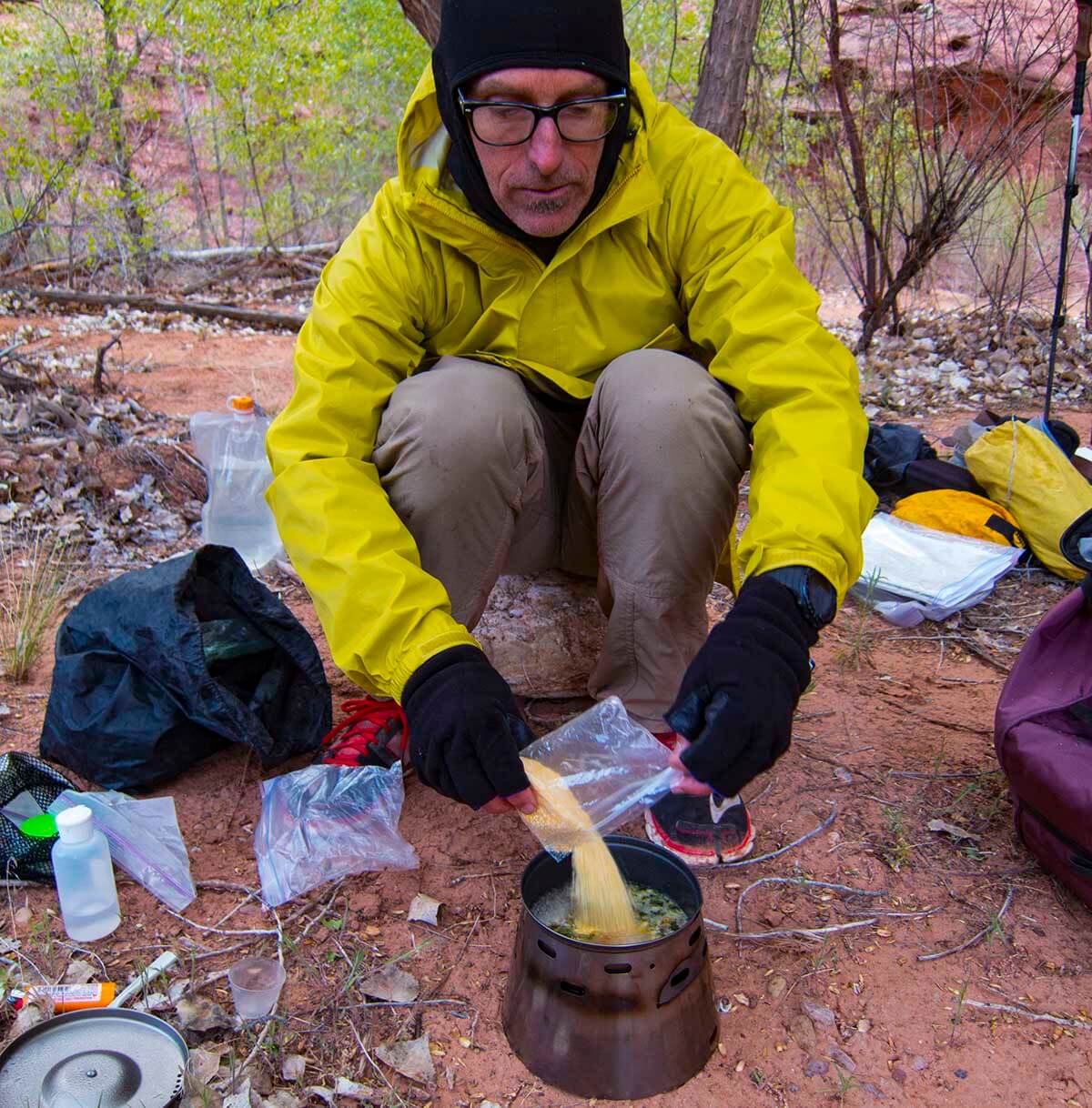
Cooking a meal in the pot does a better job of rehydrating a meal. Especially if you let it simmer for a few minutes after a boil. Downside is that the pot is harder to clean, especially with cheese. And food can burn to the pot bottom if you aren’t careful. (photo: Andrew Skurka)
Rice And Beans With Cheese And Tortilla Chips
Use these healthy freeze dried Black Beans & Rice (available at REI) or at Amazon. Open the meal bag and add 2 oz of Just Hot Veggies or any of Just Tomatoes FD veggies.
Then separately package in ziplock snack baggies:
- 3-4 oz cheddar cheese (cubed or shredded)
- 2 oz of lightly salted tortilla chips of your choice (lightly crushed)
Place both the cheese and chip baggies back in the meal bag and reseal it.
Meal Prep Directions
- pour 17 to 18 oz hot water into the meal packet and set aside to re-hydrate
- after about 5 minutes, stir in cheese
- when full hydrated (about 10 min), crumble tortilla chips over the top and enjoy!
Note: eat in packet with long spoons unless you want to be scraping cheese out of your pot and/or bowls for some time.
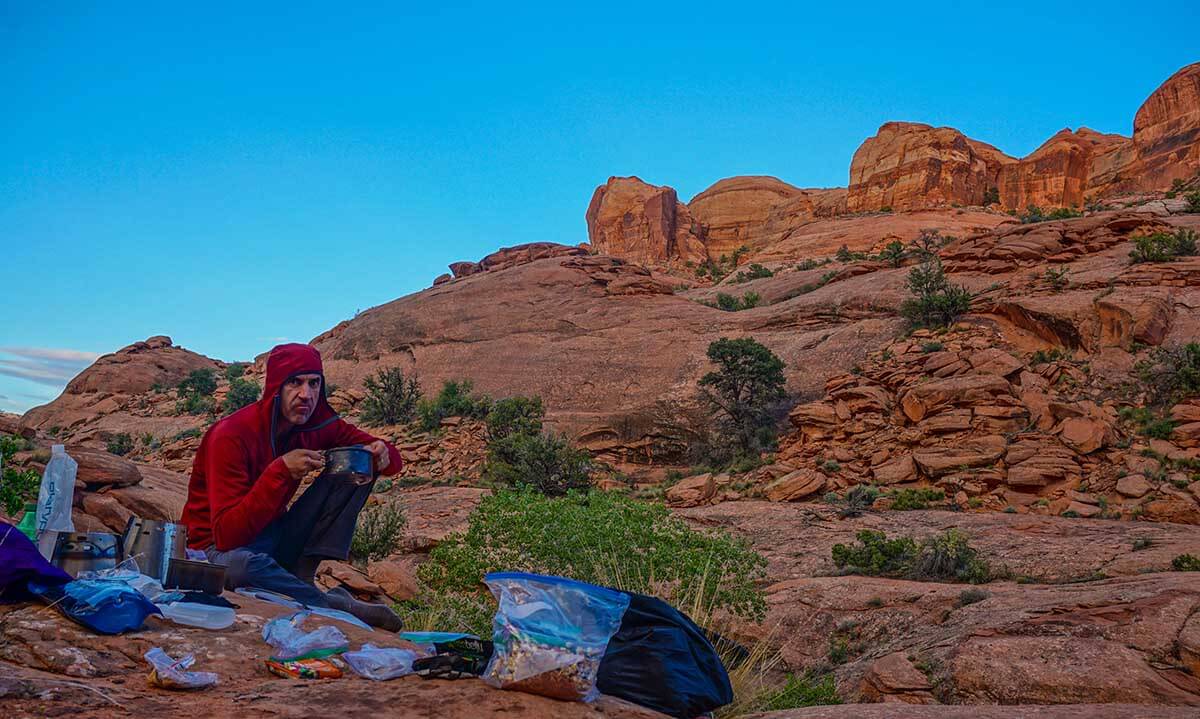
Dinner in a remote canyon in the Escalante Grand Staircase.

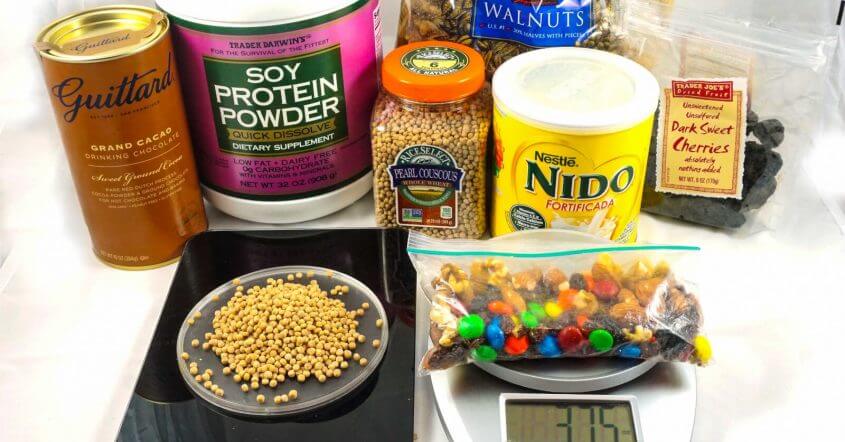


Is the elbow macaroni cooked and dehydrated? If not, do you cook it in your caldera cone kit? How do you simmer it for 1o minutes?
standard small elbow macaroni. it will re-hydrate in a freezer bag if you let it sit for 10-15 minutes. If you simmer for a few min after the boil on the TD caldera it will speed up your soaking/hydration time. But you’ll need to watch the pasta and carefully stir to prevent boil-over during your simmer. Best, -alan
Hi Alan,
Wanted to get your opinion of backpacking without a stove? I have thought about giving it a whirl but being older and a bit old school having a hot meal and coffee after a long walk is so nice. Even walking alone seems it hits the spot. Plus feel it is safer to have the ability to heat water.
Thank you
Randy
Hi, Randy. Just use a light stove. Trail life is better that way. Best, -alan
I can not get the second page of the dinner recipes to print out from google sheet. I can only print to cheddar cheese in the rice and beans recipe. Maybe a page break at this spot would resolve the issue. Great recipes. Thank-you.
Hi Alan,
Thanks for the great recipes. I plan on trying a few out on the CT over Labor Day weekend. I have a question about the grapenuts and museli breakfasts. Do you normally add cold water to them or do you boil it first?
Thanks!
Anthony
Anthony, good Q. Can be either hot or cold. Although, Alison and I have it cold about 97% of the time. Sometimes it’s a special treat on a very cold morning. Wishing you a great trek. Warmest, -alan & alison
Two things:
1.I would buy whey protein isolate for the protein powder.
2. The Honeyville Farms textured vegetable protein (chicken flavor) has some nasty ingredients. As an alternate, you could just dehydrate some lean ground chicken/beef mixed with bread crumbs. A pound of this would probably yield a cup of protein.
Really like your site. I am using some of your ideas on my next hike. Thank you.
Thanks for the kind words Cam. Wising you a great year of trekking. Warmest, -alan
It’s quite hard to get your hands on those pint-sized Ziploc bags in Europe (at least in Germany where I’m from) – an alternative is the IKEA variety named ISTAD. The bags come in different sizes, the smallest being 400ml. Just a tip …
Grrreat site, by the way! Keep it up, Alan.
Thanks for the IKEA tip Robert! Warmest, -alan
Hi, Simon again – I just had a look at the table again, measurements are in ounces. Feel free to poke fun at my previous silly question :-)
Not poking fun. Units are not nearly clear enough. Thanks for pointing it out. Warmest, -alan
Hi Alan,
Firstly thanks for sharing all this info and Hello from Australia!
I don’t really understand your tables above. For example in the brakfast recipies, Muesli recipe, you have almonds listed. For the 1/2 serve it says 0.5 for almonds. What is the unit here – 0.5 what?
Thanks,
Simon
Hi Simon. Good question about units. Sorry for the confusion. And you are right, I don’t clearly say what the units are. This is the US so, unless otherwise noted, all weight measurements are in US ounces = 28g. So it would be 14g of almonds.
Occasionally, there are volume measurements and those are in US cups, or US tablespoons, or teaspoons. Bon Appetit. Warmest, -alan
LOVE your site! Just stumbled upon this for some ways to save money and eat better on tramps (hikes). Hello from New Zealand and thanks for taking the time to share your tips.
My pleasure. Wishing you a great 2018 full of great treks. -alan
On your recipe page I see your detailed Breakfast and Diner pages lists the menu item, weight of each item, and serving sizes, I see 1/2 serving, 1, 2, and so on. It is your experience and/or recommendation that I, as a fit, 160 lbs hiker, consume 1 serving or eat 2 per meal? Do you feel that “1 Serving” is indeed enough for 1 hiker?
Thank you for helping with this question.
Mike, good Q. And a short a as I am currently trekking out of the country. I suggest you do some more reading on my site. In particularly how much food do I need. That will help you get a starting figure for how many calories of food you need a day. From there you can plan a list of all your food for the day that add up to those calories. But as to a serving size for dinner: there is no definitive A. Some people snack all day and eat a light dinner, and some eat lightly during the day and have a large dinner. Same total calories per day but difference to strategy. Personally my 1 serving is likely on the light side for a hungry male that want’s a large dinner. That’s because I do more of my eating during the day. If you like more food at dinner then I would go with 1.5x or 2x on the dinner and eat less during the day. Hope this helps. Warmest -alan
Alan, what is that veggie soup looking meal shown re-hydrating in the pic just below the recipes? Looks like it would’ve been great after hiking in the cold rain all day recently. Is that the Just Hot Veggies in the Amazon link?
Hi Mark, it’s the “Couscous Dinner – Hot Curry,” one of our favorite meals. Goes on almost every trip. And yes, great on a cold night. You can even add hot pepper flakes or Dave’s Insanity Sauce to make it hotter and warm you up more! Bon appetit. Warmest, -a
As vegans planning a thru hike on the AT next April, my wife and i found your blog very informative and encouraging! We can’t thank you enough Alan!
Absolutely. My pleasure! Warmest, -alan
Wish I could like your post 10 times. Im also vegan with 5 trips scheduled for the next two months. Cant think on a better way to travel. We stay healthier, and feel much better knowing that our actions are helping out the environment to stay as beautiful as it is for the next generations. Good luck on the AT and hope to meet you and your wife one day on a hike somewhere.
Thanks Laura. -alan
Hi Alan, Thanks for these recipes. Lots of good ideas. Also, really liked the links to products.
I noticed you used whole wheat noodles. Are you able to rehydrate these by soaking or do you have to boil them?
Thanks
Hi Pat, good Q. The smaller whole wheat pastas do reasonably well and usually re-hydrate to a decent softness when soaked in boiling water for around 10 min. [freezer bag “cooking”]. The longer the better tho. We typically use the smallest elbows we can find. Whole wheat couscous does really well. For most meals, not just pasta, if you cook in pot, a brief simmer of 1-2 minutes after boiling before taking it off the stove helps. But keep a watchful eye for boing over and/or burning to the bottom. Hope this helps. Bon appetit, -alan
Alan,
I’m a big fan of the pearl couscous as well. Do you pre-cook and dehydrate in advance so that it rehydrates quickly with minimal cook time?
Thanks,
David
David, the pearl couscous takes a bit longer to re-hydrate but not much longer than the freeze dried veggies. Usually about 10 min soak after boil does it. And we don’t mind it a bit on the al-dente side :-) Best, -alan
Great info!
One question, under the lunch section, #1 you have listed “Wrap”. What is this?
A burrito sized tortilla. Yum! Best, -alan
So, lunch #1 is cheese and mustard wrapped in a flour tortilla? Can you elaborate? What kind of cheese do you prefer and are you using flavored wraps like spinach? — I usually take hard cheese like Parmesan, Romano or Gouda.
Hi Leigh, it’s usually a whole wheat wrap but otherwise unflavored. But yes, hard cheeses like Parmesan are great. Huge flavor and some can run high in calories at around 130 cal/oz. which is great. We also like a sharp cheddar. Hope this helps, best -alan & alison
This is really helpful. Thank you so much for taking the time!
You are welcome. -a
Thanks Alan
You are doing a great service to the backpacking community. I am Leary of any soy products that are not organic. Most of the soy produced in the USA is GMO that is sprayed with roundup. Even non GMO soy that is not organic may be dessicated with roundup just prior to harvest. So I would either go organic or switch to another organic protein source. Plenty of organic plant based products out there.
Thanks Steve. More power to you. -a
Hello Alan,
I love this site. Great details and ideas for meals. I appreciate all the time you put into this. Can you tell me, when you list the lunch ideas – how do you keep the cheese from going bad over time? Considering it will be in a hot pack and may get soft mushy over time. Also, on your fruit list for lunch, are you assuming dehydrated fruit, different types each day? Just wondering how you are providing variety with this. Thanks again for clarification.
Glenn good Qs. Cheese is best eaten early in the trip, the hotter the temps the sooner you want to work through it. Usually you are good for at least 3-4 days. But honestly until it moulds it’s still good to eat (and I have even cut mould off and eaten the rest of the cheese). Avoid heat by keeping it in the middle of your pack during the day. I have friends that when in the desert wrap it in the middle of a sleeping bag during the day (make sure it is in something strong like a heavy duty freezer bag).
As to the fruit: same as the meals it’s good to rotate it. We find that three types of fruit works well. We rotate between dried mango, turkish apricots, and papaya. All unsweetened and unsulfured. But really any type of fruit you like is fine. Have a good trip, -a
Thanks!
This is a companion piece to my Best Backpacking Food – simple and nutritious – veggie and omnivore friendly which does have fair number of meat options if you read through. I have excerpted some here…
Omnivore Protein: … on the trail, for food variety and to get some extra protein I take some meat jerky (my favorites are Bison Jerky and Turkey Jerky – online, or TJs and Whole Foods) and/or hard, dry salami (I take locally made salami without nitrates). The protein in these meats along with cheese will complement the proteins in grains (rice, grape nuts, crackers, grains in energy bars, etc.) and other vegetable protein sources like soy and dried beans. Many dried meats like the hard-dry salami are also high in fat, increasing your calories per ounce.
Dried Meats: For those that are not veggie, dried meats are another option for protein and food variety. I take meat jerky (my favorites are Bison Jerky and Turkey Jerky online ore from TJs) and/or hard, dry salami (I take locally made salami without nitrates). Pacific Gold brand Beef and Turkey jerky that Costco sells doesn’t have a bunch of additives. Much cheaper than alternate sources.
Freeze dried meats: The following protein sources can easily be added to most meals and (Real meat) – freeze dried chicken or turkey (1 oz per serving). there are also FD beef and sausage options
I suspect you’re primarily vegan, but for us carnivores, I would appreciate your $.02 or experience regarding incorporating freeze-dried meats into your meals. I find that several days of carb/grain-heavy “traditional” backpacking meals do a number on my digestive tract and am trying to find ways to add meat.(I did find your dish with tuna promising.)